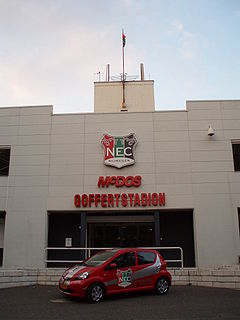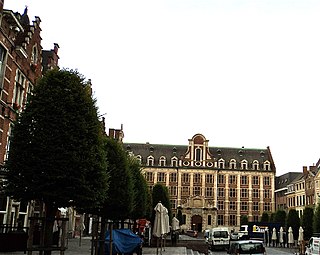
Nijmegen is a city in the Dutch province of Gelderland, on the Waal river close to the German border.

NEC Nijmegen, commonly known as NEC, is a professional Dutch association football club based in Nijmegen. The club currently competes in the Eredivisie, the top tier of Dutch football, following promotion from the 2020–21 Eerste Divisie.

Radboud University (abbreviated as RU, Dutch: Radboud Universiteit, formerly Katholieke Universiteit Nijmegen) is a public research university located in Nijmegen, the Netherlands. The university bears the name of Saint Radboud, a 9th century Dutch bishop who was known for his intellect and support of the underprivileged.
The polder model is a method of consensus decision-making, based on the Dutch version of consensus-based economic and social policymaking in the 1980s and 1990s. It gets its name from the Dutch word (polder) for tracts of land enclosed by dikes.

The Goffertstadion, formerly known as McDOS Goffertstadion[mɑɡˈdɔs ˌxɔf-] for sponsorship reasons, is a football stadium in Nijmegen, Netherlands, located in the Goffertpark. It is home to football club NEC. The stadium was opened on 8 July 1939 by Prince Bernhard of the Netherlands.

Dr. Johan (Sjeng) Kremers was the Queen's Commissioner of the Dutch province of Limburg from 1977 to 1990.
Johannes (Jan) Maria van der Lans was a Dutch professor in the psychology of religion at the Catholic University of Nijmegen.

Gerard or Gérard (de) Lairesse was a Dutch Golden Age painter and art theorist. His broad range of skills included music, poetry, and theatre. De Lairesse was influenced by the Perugian Cesare Ripa and French classicist painters such as Charles le Brun, Simon Vouet and authors such as Pierre Corneille and Jean Racine. His importance grew in the period following the death of Rembrandt. His treatises on painting and drawing, Grondlegginge Ter Teekenkonst (1701), based on geometry and Groot Schilderboek (1707), were highly influential on 18th-century painters.

Johan Nieuhof was a Dutch traveler who wrote about his journeys to Brazil, China and India. The most famous of these was a trip of 2,400 kilometers (1,500 mi) from Canton to Peking in 1655-1657, which enabled him to become an authoritative Western writer on China. He wrote An embassy from the East-India Company containing the written account of this journey.

Corneli(u)s Rudolphus Theodorus, Baron Krayenhoff was a physicist, artist, general, hydraulic engineer, cartographer and – against his will and for only a short time – Dutch Minister of War.
Jan Jozef Lambert van Hoof was a member of the Dutch resistance in World War II, who cooperated with Allied Forces during Operation Market Garden. He is credited with disabling explosives placed by the Germans to destroy a vital bridge to delay allied liberation, and was later executed in action. Before and during the war, Van Hoof was a Rover Scout, and the Scouting medal the Nationale Padvindersraad was named in his honour.

Nijmegen Lent is a railway station located in Lent, just north of Nijmegen, Netherlands. The station was opened on 1 June 2002 and is located on the Arnhem–Nijmegen railway. The train services are operated by Nederlandse Spoorwegen.

Wilhelmus Johannes Gerardus Maria "Wim" van de Camp is a Dutch politician who served as a Member of the European Parliament (MEP) between 2009 and 2019. He was the leader of the Christian Democratic Appeal (CDA) delegation, part of the European People's Party, from 2009 to 2014. He was previously a member of the House of Representatives of the Netherlands from 1986 to 2009) where he was active in the fields of education, justice and asylum policy.

Mariken van Nieumeghen(Mary of Nijmegen) is a miracle recorded in a Middle Dutch text from the early 16th century. The protagonist Mariken of the story spends seven years with the devil, after which she is miraculously released. The oldest edition dates from 1515 and was printed by Willem Vorsterman. Linguistic evidence suggests it was written by a poet from an Antwerp chamber of rhetoric.

Trinity College was one of the colleges of Leuven University, dedicated to preliminary studies in the liberal arts. The college was established by the university authorities in 1657 to replace the "Collège de Gand" founded by Frans van de Nieulande in 1559, which had closed in 1655 for lack of funds. Building began in 1658, under the supervision of Jan du Can and Adriaan van Mechelen, and from 1659 the college was housed on the Old Market. It was sometimes known as "Collegium Novum". The college was sequestered when the university was closed down in 1797 during the French occupation. The buildings were sold at public auction in 1802. The southern wing, added in 1684, was demolished in 1813. The final remnants of the 17th-century buildings were destroyed by aerial bombardment in May 1944. Since 1843 a Josephite secondary-school, Heilige Drievuldigheidscollege, has stood on the location.

The bombing of Nijmegen on 22 February 1944 was an opportunistic aerial bombing raid by the United States Army Air Forces on the city of Nijmegen in the Netherlands, then occupied by Nazi Germany. In terms of the number of victims, it was one of the largest bombardments of a Dutch city during World War II. Officially, nearly 800 people were killed by accident due to inaccurate bombing but, because people in hiding could not be counted, the actual death toll was probably higher. A large part of the historic city centre was destroyed, including Saint Steven's Church. Saint Augustine's Church and Nijmegen railway station were heavily damaged as well.

The siege of Nijmegen was a military engagement during the Eighty Years' War and the Anglo–Spanish War which took place from 17 to 21 October 1591. The Spanish garrison in Nijmegen was besieged by a Dutch and English force under Maurice of Nassau and Francis Vere respectively, which soon surrendered.

The Battle of Nijmegen or Liberation of Nijmegen occurred in the Netherlands from 17 to 20 September 1944, as part of Operation Market Garden during World War II.

The Siege of Nijmegen occurred from 27 October to 8 November 1794 during the Flanders campaign of the War of the First Coalition. It was the last major military confrontation between the forces of the Revolutionary French First Republic and the reactionary First Coalition of European monarchs including William V, Prince of Orange, before the fall of the Dutch Republic in January 1795, which William had ruled as hereditary stadtholder since 1751. As commander-in-chief of the Dutch States Army, his indecision, several changes of mind and lack of coordination with his Anglo-Hanoverian, Hessian, Prussian and Austrian allies contributed to the eventual surrender of Nijmegen to the French revolutionaries.
Johannes Ernest Everard "Jan" Keunen is a Dutch ophthalmologist, professor, and politician. After studying medicine at Radboud University Nijmegen and receiving his doctorate in 1988, he worked at academic hospitals in Utrecht, Leiden, and Nijmegen. He was appointed to the Senate in October 2020. Keunen is a member of the conservative–liberal People's Party for Freedom and Democracy (VVD) and has supported banning the sale of consumer fireworks.
















